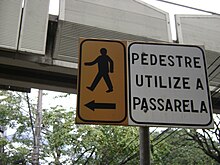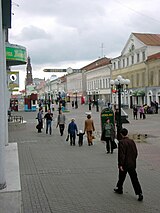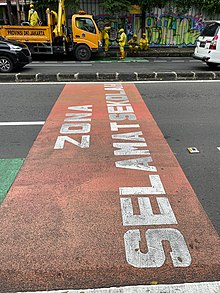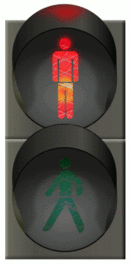Pedestrian
[citation needed] In modern times, the term usually refers to someone walking on a road or pavement (US: sidewalk), but this was not the case historically.The word pedestrian may have been used in middle French in the Recueil des Croniques et Anchiennes Istories de la Grant Bretaigne.During the rest of the 19th century, many people tried to repeat this feat, including Ada Anderson who developed it further and walked a half-mile (800 m) each quarter-hour over the 1000 hours.There are also footpaths not associated with a road; these include urban short cuts and also rural paths used mainly by ramblers, hikers, or hill-walkers.The UK Highway Code advises that pedestrians should walk in the opposite direction to oncoming traffic on a road with no footpath.Airports, museums, campuses, hospitals and shopping centres might have tools allowing for the computation of the shortest paths between two destinations.In Copenhagen, the world's longest pedestrian shopping area, Strøget, has been developed over the last 40 years, principally due to the work of Danish architect Jan Gehl, a principle of urban design known as copenhagenisation.[13] The Traffic Injury Research Foundation describes pedestrians as vulnerable road users because they are not protected in the same way as occupants of motor vehicles.In such a situation, an adult pedestrian is struck by a car front (for instance, the bumper touches either the leg or knee-joint area), accelerating the lower part of the body forward while "the upper body is rotated and accelerated relative to the car," at which point the pelvis and thorax are hit.[18] The advent of SUVs is considered a leading cause;[19] speculation of other factors includes population growth, driver distraction with mobile phones, poor street lighting, alcohol and drugs and speeding.[18] Cities have had mixed results in addressing pedestrian safety with Vision zero plan: Los Angeles fails while NYC has had success.This defect might more easily be observed on arterial roadways, intersections and fast-speed lanes without adequate attention to pedestrian facilities.[13] For this reason, some European cities such as Freiburg (Germany) have lowered the speed limit to 30 km/h on 90% of its streets, to reduce risk for its 15 000 people.)[13] A similar set of policies to discourage the use of cars and increase safety for pedestrians has been implemented by the Northern European capitals of Oslo and Helsinki.








Pedestrian (disambiguation)crosswalkBuenos AiresBelo HorizonteBraziloverpassmobility aidsmorphemesPedestrianismPeter NortonequestrianismRobert Barclay AllardiceStonehavenAda AndersonRacewalkingOlympicLand's End to John o' GroatsDave KunstWaseca, MinnesotacharitablefundraisingJimmy SavileIan BothamSanta AnaCaliforniaBauman StreetRussiaUnited StatesDTW airporttrafficsidewalkNorth American EnglishBritish EnglishAustralianNew Zealand EnglishtrailsvehiclesPeterboroughshared use pathspedestrian crossingsfootbridgeBlackwall TunnelDartford CrossingThe UK Highway CodeOpenStreetMapMobility transitionadvocacypedestrian zonesurbanistsNew York Citypublic transportCopenhagenStrøgetJan GehlcopenhagenisationJakartaislandsHelsinkiFinlandTraffic lightsFreiburgZone 30Pornainennatural environmentobesityinternal combustion enginespublic transportationUnicodehexadecimalDériveFootpathJaywalkingJunior safety patrolList of U.S. cities with most pedestrian commutersPedestrian villagePedestrian zoneStreet reclamationTraffic calmingTrail ethicsWalkabilityWalking auditWalkingFederal Highway AdministrationU.S. Department of TransportationFederal Highway Administration (FHWA)BibcodeWorld Health OrganizationThe GuardianGuardian News & Media LimitedDetroit Free PressEuropean CommissionUnicode ConsortiumBematistBaby walkerCrossing guardDog walkingGuide dogPedometerWalker (mobility)Walking busWalking stickDromomaniaHand walkingKnuckle-walkingPreferred walking speedWalking distance measureGinnelDrovers' roadEsplanadePedestrian crossingXiaolürenFlâneurHikingLong-distance footpathsMall walkingNordic walkingShatapawaliSpeed walkingStrollingWalking tourPedestrian circumnavigatorsSlow marathonInternational charter for walkingInternational Federation of PedestriansMetrominutoNational Pedestrian Day
